
Official Edgar Rice Burroughs Tribute and Weekly Webzine Site Since 1996 ~ Over 15,000 Web Pages in Archive Presents Volume 5875 |

Official Edgar Rice Burroughs Tribute and Weekly Webzine Site Since 1996 ~ Over 15,000 Web Pages in Archive Presents Volume 5875 |
![]()
Edgar Rice Burroughs
and the Lunacy Legacy of Mars
By Abraham Sherman
![]()

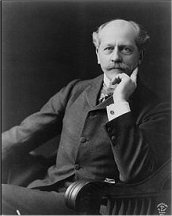
Imagination is as vital to any advance in science as learning and
precision are essential for starting points. (Percival Lowell)
“Burroughs is probably the most influential writer in the entire history of the world. By giving romance and adventure to a whole generation of boys, Burroughs caused them to go out and decide to become special. … I've talked to more biochemists and more astronomers and technologists in various fields, who, when they were ten years old, fell in love with John Carter and Tarzan and decided to become something romantic. Burroughs put us on the moon.” (Ray Bradbury, Listen to the Echoes: The Ray Bradbury Interviews, 2010) When pitching Tarzan of the Apes to All-Story magazine editor Thomas Metcalf in 1912, ERB referred to the project as “another story of the 'unlikely' variety.” This was an allusion to the “unlikely” subject matter of his first novel, A Princess of Mars (APOM). He had written his Mars novel under the pen-name of “Normal Bean” to assure readers that, though the tale was bizarre, he was still in his right mind. As a fan of Percival Lowell (Mars, 1895; Mars and Its Canals, 1906; and Mars as the Abode of Life, 1908), ERB was intrigued by speculations about Martian canals and cities and the intelligent life which must have constructed them. The fact that ERB thought of APOM as "unlikely" confirms that he thought of Lowell's speculations as just that -- speculations.
The Mars of Normal BeanThe genius of ERB was that he didn't let the likelihood of a barren Mars hold him back. ERB treated his vivacious rendering of Mars, named Barsoom by its inhabitants, with historical certainty. The first-person voice of John Carter in APOM relates his discoveries in the same style as the travelogues which were common in National Geographic in the era when APOM was written. This trip just happened to be to the ambitious and "unlikely" setting of Mars!
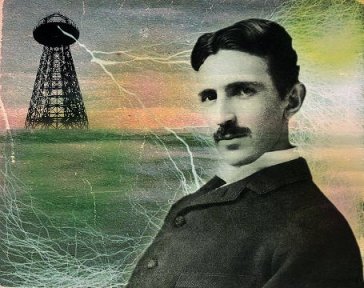
TESLA PROMISES COMMUNICATION WITH MARS
Richmond Times 1901 :: Chicago Tribune 1901Whether or not it was a conscious effort, ERB's approach to his Mars tales ended up tapping into the universal fascination with the concept of the frontier. ERB's various occupations, before turning to writing at the age of 35, had familiarized him with exploration and the idea of pushing past the horizons of what was then known and understood. He had worked as a miner, rancher, and cavalryman in the Old West of Idaho and Arizona around the turn of the century. He had personally watched as the wild frontier of North America had dissolved into familiarity, from the perspective of the European immigrants of the previous several centuries. One reason he set Tarzan in "deepest, darkest Africa" was because there was still a sense of untamed frontier there. The January 1911 issue of National Geographic featured an article entitled “Wild Man and Wild Beast in Africa,” by Theodore Roosevelt.
ERB, never one to put forth a boring frontier, gave his Mars all the exotic life, elaborate cultures, mind-boggling technology, epic martial conflicts, and emotionally rich history that his uniquely talented imagination could produce. The appeal of Barsoom was never contingent upon its reality. Its existence was always unlikely. It was enthusiastically embraced upon its original publication in 1912 (prompting Metcalf to request a sequel), and continues to be embraced today, because it captured the thrill of an unexplored horizon – a thrill which was on the verge of being extinguished worldwide by discovery, at the time ERB wrote the story. ERB and his original readers were already mourning the death of the seemingly limitless possibilities that passed away with the taming of the American West. Mars as a fantasy world came to fill a void in the collective imagination which Earth could no longer satiate. Whether there truly were giant green men, airships, or many-legged beasts was secondary – humanity’s instinct to explore required the fuel for speculation which ERB provided. Without such fuel, the muscles of imagination, innovation, and ambition inevitably atrophy.
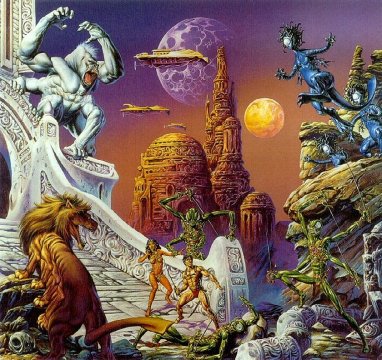
Barsoom by Joe Jusko ~ ERBzine 1351Today, Mars remains a source of speculation. In-person exploration will be possible in the next ten to twenty years. As the frontier of exploratory science, Mars is the next place that humans must go. And we will go, if we wish to continue to benefit from the senses of purpose and motivation offered by our innate curiosity. The romance of the unknown persists there, on the grandest scale humanity has ever encountered. Mars is the primary catalyst for conjecture about alien planets throughout the universe - a unique status it has held for centuries. This status was given its greatest jolt of life by ERB. As long as we continue to explore to the limits allowed by our technology, and continue to exhaust the unknown, we will need pioneers of imagination like Edgar Rice Burroughs to provoke our curiosity, inspire our dreams, and put the carrot just beyond our reach yet again.
On occasion, we need imaginative visionaries to keep the flame alive amidst a downpour of disappointments and setbacks. After the Mariner fly-bys of the 1960s and the Viking landers of the 1970s revealed an apparently lifeless world, the excitement over the possibility of Martian biology was severely deflated. Some degree of imagination and enthusiasm for interplanetary science died the day we viewed the first Mariner photograph. The simple desire remained to set foot on Mars and explore, while the scientific impetus for funding such expeditions waned. Thankfully, Burroughs, and others who followed in his grand tradition of creating adventures on other planets, were there to keep alive the romance of alien life. A world that “might” have bacteria does not keep an inspirational spark alive with anywhere near the effectiveness of a living world like Barsoom. Even though Barsoom is impossible, it nevertheless gives us hope that other habitable worlds may yet be within our reach somewhere not too far away. Space exploration will proceed with genuine enthusiasm only if we keep reminding ourselves of the simple wonder of discovery. To read God’s Book of Nature is wondrous – every detail is a miracle.
The natural sciences tell us that Barsoom does not exist. Psychology, sociology and the humanities tell us that it should exist. Barsoom, as an archetype of the perpetual frontier of space exploration, is essential in terms of what gets people out of bed every day, and what evokes the joie de vivre. We must each believe that the frontier in front of us is limitless, beautiful, exciting, and worth it. ERB, perhaps in a way unmatched by other writers, crystallized those essential life ingredients of hope, optimism, and inspiration in his fiction. The man believed in the possibilities of a courageous life, and freely shared his sentiments in some of the most imaginative and entertaining stories ever written. He made his stories accessible to the ten-year-old that every person is at one point, the ten-year-old who needs to have his dreams enlivened forever and needs to see examples of excellent moral character. The people in ERB’s Mars books show us ourselves. Its heroes and villains are the angels and demons who perch on our shoulders.
Burroughs’ themes and imagination are exemplary. His ability to combine timeless meaning and entertainment resulted in his first novel, APOM, becoming what is perhaps the most influential work of popular fiction of the last century. It could be said that more people have been entertained and inspired by ERB than by any other author since 1912, whether they have experienced his works directly or not, and whether they have known him by name or not. Anyone who has been thrilled by the last century of characters with superpowers, any child (or child at heart) who has set out to become a Jedi knight, anyone who has dreamt of living on a world like Avatar's Pandora, has been thrilled, inspired, and taught to dream by ERB, via those whom he inspired. He, like JRR Tolkien (The Hobbit, The Lord of the Rings), has proven to be one of the best authors at fostering imagination and inspiring dreams. ERB’s one-hundred-plus years of extraordinary influence on popular culture speaks to the unique power of the lightning he bottled. Modern superheroes, Star Wars, and Avatar, all owe more to ERB than to any other individual, according to statements by Jerry Siegel, George Lucas, and James Cameron.
Lightning and a BlazeIn terms of imagination, adventure, and inter-planetary romance, filmmaker James Cameron’s Avatar felt very much like an ERB novel. Avatar was the most financially successful film ever made, expanded the cinematic toolbox for imaginative filmmaking, and raised the standard for escapist movies.“John Carter was able to leap great distances because the planet Mars was smaller than the planet Earth, and so he had great strength. I visualized the planet Krypton as a huge planet, much larger than Earth, so that whoever came to Earth from that planet would be able to leap great distances and lift great weights.” (Jerry Siegel, creator of Superman, 1983) “Originally, I wanted to make a Flash Gordon movie, with all the trimmings, but I couldn’t obtain all the rights. So I began researching and found where (Flash Gordon creator) Alex Raymond got his idea: The works of Edgar Rice Burroughs, especially his John Carter series of books.” (George Lucas, creator of Star Wars, Science Fiction Review, December 1977)
"In the grand tradition of Edgar Rice Burroughs' 'John Carter of Mars'" (George Lucas, synopsis of Star Wars, May 1, 1975)
“With Avatar, I thought, forget all these chick flicks and do a classic guys' adventure movie, something in the Edgar Rice Burroughs mold, like John Carter of Mars." (James Cameron, creator of Avatar, The New Yorker, October 26, 2009)
Ray Bradbury (Fahrenheit 451, The Martian Chronicles, The Illustrated Man), was one of ERB’s most outspoken advocates in the literary realm, and took every opportunity to express his regard for ERB. Bradbury’s assertion that ERB’s spark of imagination caught fire to a degree not achieved by any other writer in history is supported by quotes from countless writers, filmmakers, scientists, and public figures over the last century.
ERB was a destiny-changer, and continues to be so, through the many influential individuals his works have inspired.“I've always wanted to bring a serial to life that blends… elements from Edgar Rice Burroughs and [George Lucas’] great imagination.... [Raiders of the Lost Ark] found its own fantastic elements in a genre that sadly has been dormant for decades in American cinema.” (Steven Spielberg, Starlog Magazine, August 1981) “I wish I had more control, more like Edgar Rice Burroughs had, but I'm a realist, too. I work in television. I don't know that I would want to spend the rest of my life controlling my characters.” (Gene Roddenberry, creator of Star Trek imdb.com/name/nm0734472/quotes)
“‘How did a little girl growing up in England before World War II get involved with studying Chimpanzees? I owe just about everything I've done right with my life and nothing I've done wrong in my life to my mother.’ Her mother supported her passion and curiosity for all living things and introduced Goodall to the book Tarzan of the Apes by Edgar Rice Burroughs when she was 11 years old. ‘Of course I was jealous when he married that wimpy other Jane,’ Goodall said. At 11 years old she decided she would move to Africa and study the native animals of the undiscovered dark continent.” (Jane Goodall, primatologist, Quinnipiac University Chronicle, Connecticut, November 2, 2005)
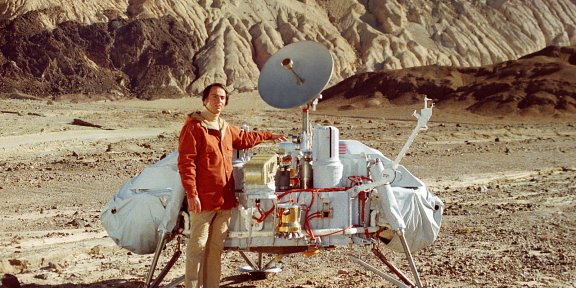
Carl Sagan Astronomer ~ ERBzine 1384
“I can remember as a child reading with breathless fascination the Mars novels of Edgar Rice Burroughs. I journeyed with John Carter, gentleman adventurer from Virginia, to ‘Barsoom,’ as Mars was known to its inhabitants. I followed herds of eight-legged beasts of burden, the thoats. I won the hand of the lovely Dejah Thoris, Princess of Helium. I befriended a four-meter-high green fighting man named Tars Tarkas. I wandered within the spired cities and domed pumping stations of Barsoom, and along the verdant banks of the Nilosyrtis and Nepenthes canals. Might it really be possible – in fact and not in fancy – to venture with John Carter to the Kingdom of Helium on the planet Mars? Could we venture out on a summer evening, our way illuminated by the two hurtling moons of Barsoom, for a journey of high scientific adventure? ... I can remember spending many an hour in my boyhood, arms resolutely outstretched in an empty field, imploring what I believed to be Mars to transport me there.” (Carl Sagan, astronomer, Cosmos Television Mini-series, 1980)
“Edgar Rice Burroughs' stories about Tarzan, John Carter and David Innes were great. His characters are true classics...everything I read in comics and books made me want a life of adventure. In that respect, [they were] a motivating factor -- a strong one at that. And I can say [that such] characters helped me be honest and morally strong. They were good examples to emulate when you are growing up. The people who write science-fiction stories are dreamers. They create the ideas from which scientists begin their search. Just think what this country would be like if we did not have writers who dream of making things better.... Without the dreamers, our country could be in pretty bad shape. Science fiction is the material from which dreams begin their initial journey to reality. Without that first building block, we, as a nation, cannot advance and we would eventually stagnate. A stagnating civilization will eventually collapse in on itself. I would have never gone into space had it not been for someone in the past who one day wondered if space travel was possible; that person dreamed the dream and I was very fortunate to be able to fulfill his dream from long ago.” (Terrence Wilcutt, four-time shuttle astronaut, now a NASA administrator, Hogan’s Alley Magazine, #4)
“I am amazed at how few people I meet today know that Burroughs also provided an introduction to science fiction with John Carter of Mars and the other books he wrote about John Carter and his frequent trips to the strange kingdoms to be found on the planet Mars.” (Ronald Reagan, actor and United States President (1981-1988), 1981 letter)
“As a boy, I loved reading the Tarzan adventure books by Edgar Rice Burroughs.” (Billy Graham, evangelist, In His Own Words, January 19, 2015)
The connection between ERB's Mars stories and the current popularity of science fiction and superheroes has yet to be made for the majority of the general public. However, most people are familiar with ERB’s other famous hero, Tarzan. As comic book writer Ron Marz has noted, the difference in public awareness between Tarzan and John Carter is due to the many ways that Tarzan has been seen in the media (http://www.comicmix.com/2015/08/24/ed-catto-man-from-marz-still-kicking-at-103/). John Carter didn't get his first movie until Tarzan had already appeared in over fifty authorized films, plus TV shows, radio broadcasts, and all manner of print media.
Fanning the Flames on FilmThe Asylum’s Princess of Mars (2009), and Disney’s John Carter (2012), were film adaptations of APOM, but diverged from the source material in ways that diminished their cinematic effectiveness. See “John Carter of the Round Table: An Exploration of the Differences Between Edgar Rice Burroughs' Novel and Andrew Stanton’s Film” at http://www.erbzine.com/mag43/4399.html for a more detailed analysis of Disney’s John Carter. Ironically, the potential of a no-holds-barred Barsoom film adaptation was better illustrated, in grand form, by Avatar. Even that phenomenally successful film only scratched the surface of the cinematic potential inherent in Barsoom. Those familiar with Barsoom know that we have yet to see onscreen a geographically varied, multi-species populated, post-apocalyptic, archetype-steeped, dreamscape-evoking, cultural pressure-cooker planet of the type that ERB gave us. His Mars offers an invigorating breath of fresh air to the film audiences of today and tomorrow.
Taking the people of today on the adventure to find the source of the science-fiction and superhero deluge of popular culture in which they live, and re-awakening them to the necessary and essential qualities of the original, is a goal that would be best accomplished via a more faithful and ambitious Barsoom feature film adaptation. Barsoom is the type of world cinema was made to portray. Cinema that wishes to become an experience, rather than just a temporary distraction, must pursue and capture the heart. This is a tall order which the Barsoom novels have proven themselves capable of filling.
In the film industry, one of the foremost questions asked about any script is “Where’s the love story?” With ERB’s Barsoom, it is easier to ask “Where isn’t the love story?” His Mars tales celebrate many types of “love,” including service, friendship, camaraderie, sacrifice, romance, devotion, and the most important of all: family. One of ERB’s goals for APOM, the first Barsoom novel, was to create a “love feast” (Edgar Rice Burroughs, letter to Thomas Newell Metcalf, August 26, 1911). Generations of captivated fans attest that he succeeded.
Stories can get all of the machinery of proper story structure just right, and still feel flat if there is no element of romance. Movies that are primarily about the mind can be fascinating, but movies which capture the heart, when complimented with elements that appeal to the mind, turn filmgoers into devotees. People appreciate movies which are politically, religiously, or philosophically affirming, but they are captivated by films which have emotional resonance - to some extent even when the story counters previously held beliefs. Emotionally captivating stories may or may not be set in a familiar world with familiar ideas. In fact, stories of a more exotic and imaginative nature can often be more emotionally effective, as the sense of being in a different reality diminishes any “red flag” effect among the audience. If a story set on another world (whether in a science fiction, fantasy or historical setting) is internally consistent and effectively conveyed, the defenses of the mind are lowered. This increases the chances for the heart to take primacy. Emotional effectiveness coupled with truth creates a powerful film. Films of this type eschew cynicism and are purposely vulnerable. They celebrate the things which bring people fulfillment and joy in their everyday lives: goodness, truth, and beauty. Barsoom, with its brilliant imagination, its celebration of the classical virtues, and its many layers of romance, stands as one of the strongest fictional worlds ever created.
The scientific condition, technological achievements, and political structures of Barsoom provoke and intrigue the mind; while its wistful history, its heroes’ continual pursuit of honor and justice, the romance between John and Dejah, the forbidden romance of Tars Tarkas and Gozava, the courageous family love of Tars Tarkas and Sola, the way the heroes of each nation fight in the chivalrous romantic tradition, and the faithful steed and loyal hound companionship of the thoats and Woola provoke and satisfy the heart. Those who look for the “love story” on Barsoom find it in abundance. ERB’s world teaches courage, friendship between cultures despite old and deep wounds, and the need for strong moral character. The danger of forgetting traditional values is illustrated in the depravity of Barsoom’s villains. On Barsoom, revolutions of the heart come first and inspire the secondary changes of political and national reforms.
Why do people count down the days (and even hours) until the release of the next Star Wars film? It’s not just because they think it’ll be first-rate sci-fi; it’s because that galaxy has proven to hold incredible promise for romance. It can captivate the heart via the fight for freedom and ideals, the heroic service of the Jedi, the childlike innocence and eccentricities of the droids, the endearing scoundrel Han Solo, and the huggable nature of the mighty Chewbacca. The audience is able to take or leave any subtle political messages as they please, because they’ve already been sold by the emotion.
It is one thing to understand the goal of emotional captivation, and quite another to accomplish it. Yes, Barsoom has tremendous cinematic potential, but how can it be realized? One clear precedent for how to approach a Barsoom film adaptation is provided by a movie based on a novel by James Fennimore Cooper. His Leatherstocking Tales are pulpy, with a Burroughsian sense of adventure and swashbuckling action. Yet, when adapted in the form of the Last of the Mohicans film, the stories were given the historical epic treatment and a dramatically powerful film resulted. That approach of taking a pulp-paced text and maximizing its gravitas is also the key to leveraging the entirety of what ERB invested in the Barsoom source material. Some of the most promising elements of the novels are touched on only lightly by ERB, and can be developed organically from the source material to enhance a film adaptation. Insights for how to accomplish these enhancing developments, and what to emphasize, are found in stories that have endured for millennia. For example, the accounts in the Bible remain as compelling as ever, describing people who have the same basic humanity as any of us, despite being from different times and different cultures. A Barsoom film adaptation would be strengthened by taking cues from the Biblical approach to conveying history and universal humanity. Along with its otherworldly strangeness, Barsoom has much to say about justice, honor, and love that will always be relevant to the here and now.
How to Get to ERB's MarsERB’s Mars is indeed the sphere of war. In terms of battles, adventures, and creatures, ERB’s Barsoom gives us something akin to the epics of Homer on an exotic, ancient, richly imagined, science-fantasy alien world. Taking the “world of war” identity as the thematic approach for the adaptation could capitalize on the singular place that Mars occupies in the collective imagination and provide insights into conflicts and heroism that would speak to any planet at any time.
By gleaning insights from Last of the Mohicans, the Bible, and Homer’s Iliad and Odyssey, the path is revealed to a Barsoom film that is both strange and familiar, both historical and ageless, both tearful and exultant, and is full of ERB’s trademark adventure and romance. The legends and archetypes which characterize the Barsoom tales illustrate that ERB followed the same approach when crafting the original novels. To take the historical, mythical, and thematic contents of ERB’s imaginative writings and translate them into a film, with an appropriately epic tone, is an intimidating and thrilling prospect. Such a production would be an enormous task for everyone involved. The worthy challenge would gradually give way to profound satisfaction gained from bringing the incomparable world of Barsoom to life. This cause warrants the utmost support that professional filmmaking has to offer, both in terms of talent and financial resources.
If a filmmaker appropriates what has worked well in previous successes in the science-fiction, fantasy and historical epic genres, he can apply that knowledge to creating this film adaptation. ERB has provided all the ingredients for success. A Barsoom film adaptation operating at its full potential has the opportunity to make a splash in today's movie world the way ERB's novel made a splash in the fiction world of 1912 – by bringing elements of the greatest stories in history into a powerful synergism, woven together with unique and wild imagination.
The trump card of this proposed Barsoom reboot is the as-yet untapped epic history of the planet, and how that emotionally resounding history bears on the planet’s current events. Few films which mix science-fiction and fantasy have approached the depth of lore seen with Barsoom. ERB’s Mars is a world of legends, civilizations, ruins, wars, and heroes. The history of Barsoom is as grand in scope as the history of J.R.R. Tolkien’s Arda, though ERB did not flesh out the historical details of his planet to the same extent. Audiences resonated with the Middle-earth films, which were based on Tolkien’s novels. This is an indicator that a Barsoom reboot should trust the rich historical foundation of Barsoom, and capitalize on the importance of that history in the present-day of the planet, for the purposes of cinema.
The historical quality of ERB’s work allows for an adaptation that is thematically and tonally akin to Lawrence of Arabia, Last of the Mohicans, Braveheart, and Lord of the Rings, with visual allure pushed beyond Star Wars and Avatar. The Barsoom novels feature a failing, lavish ancient planet and the current, decisive struggles over its destiny. Barsoom is a world where a reader can still hear the echoes of its ancient people, in laughter and in battle, can still see the majestic ships in its dry seaports, can still sense the dreams and desperation that built and abandoned its ruined cities. Barsoom remembers its past of tragedy and accomplishment, and is dogged by mysteries and tensions that persist to the present and groan for resolution.
In terms of how it captivates an audience, imaginative cinema is an artistic medium of impulse and primal allure, of blood and fire. ERB’s work moves with this same visceral energy. To match the “fuel” of Barsoom with the vehicle of cinema could enable both the author and the visual medium to achieve their complimentary goals to an unprecedented degree. This property offers a rare shot at historical science-fantasy, a hybrid genre which has the potential to become the new summit of cinematic entertainment.
Those who plan to climb a mountain must familiarize themselves with its challenges. Effective preparation and careful decision-making are required in order to summit safely. What are the "do's and do not's" of a successful Barsoom film adaptation? As was the case with the film adaptations of The Lord of the Rings, Barsoom is a literary property that must be allowed to be itself. Publicity for the production will need to frequently refer to the legacy of the source material, and confidently convey the appealing qualities of Barsoom: otherworldly imagination, moral clarity, chivalry, heroism, romance, adventure, historical gravitas, etc. The filmmakers will have to understand what makes the books great, and apply themselves to translating those strengths meticulously to cinema.
Don’t "Crater" to the AudienceDrifting away from the books is more of a temptation with an adaptation of APOM than with adaptations of most other books because of the delicate balance required to write an exciting script which preserves the timeless elements that give the books their unique power. Impetuous modernization of the material has proven to be particularly detrimental with this property. Many writers of adaptations start innovating drastically per their own style or “voice”, rather than committing to the more painstaking route of wringing every ounce of strength out of source material on its own terms. The writers of a Barsoom adaptation might find it tempting to discard the more demanding and timeless elements of chivalry and heroism in favor of the more familiar modern stock of cynicism and expediency. That approach would rob the adaptation of much of its soul and severely cripple its enduring traction in the public consciousness.
Another factor to be wary of when adapting ERB’s Mars is that fast and casual innovation will almost inevitably give way to influences, subconscious or otherwise, derived from the numerous other properties that were themselves largely derived from ERB’s work. If the writers are not careful, the film could easily begin to look like a copy of the copies, rather than the bold and crisp original.
Someday, filmgoers will see a new movie set on Mars, and they will "get it" in a surprising and wonderful way. The Barsoom film that still waits in the source material will do for the science fiction and superhero genres what the film adaptations of The Lord of the Rings did for the fantasy genre; it will re-shape people’s understanding of the last century of storytelling and provide new perspective on phenomenally successful genres. This film will inspire in viewers new and stronger beliefs about the future possibilities for science fiction and fantasy – an effect that ERB’s work has had from the beginning. After various attempts at the adaptation of Barsoom since the early 1930’s, a compelling moment is yet to be seen – the moment when the original work will step into the cinematic arena in its full strength and demonstrate to the audiences of today why it has had its influence. Someday, filmgoers will line up at the cinema to see a film titled something like John Carter and A Princess of Mars – the story of an immortal man, an incomparable Princess, and a legendary world at war. May many more generations of future dreamers and explorers find their way to the unparalleled works of Edgar Rice Burroughs, and from there to who-knows-where.
A Smooth Landing, A New HorizonAccording to Ray Bradbury, ERB has already put us on the Moon. ERB’s spark of imagination, and his ability to elicit wonder and inspire dreams, have accelerated our journey along the path to Mars and the celestial bodies beyond. Those who collaborate on a Barsoom reboot will have the unique privilege to make a film that, in its wild imagination and its wonder-driven marketing, will join ERB in his inspirational legacy and further speed humanity’s progress into space. The living Mars that "should have been" was given to us by Chicago's most over-qualified pencil sharpener salesman of 1911. He shared with us his dream of another world, strange and familiar. It remains just a leap away.
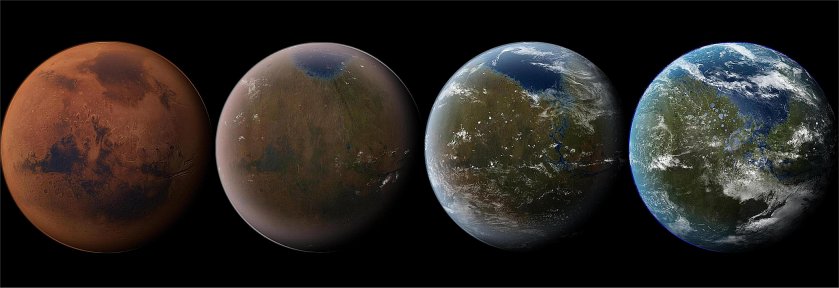

RELATED INFORMATION IN ERBzine
Read A Princess of Mars in eText
A Princess of Mars: ERB C.H.A.S.E.R. Entry
John Carter the Movie
Asylum's Princess of Mars _ II _ Novelization
www.johncarterofmars.ca
Guide to the Mars Novels of Edgar Rice Burroughs
1911/1912 Correspondence Between ERB and Metcalfe of All-Story
PROOFS OF LIFE ON MARS By Percival Lowell, LL.D ~ June/1908
Percival Lowell :: Chicago Press :: Chicago Press II
ERB in the Wild West :: Idaho
Avatar
ERB Influence and Tribute Quotes
NASA Astronaut Terry and Dennis Wilcutt in Conversation in ERBzine
Burroughs Crater on Mars and Barsoom Maps
The Edgar Rice Burroughs / Tesla Connection
The Edgar Rice Burroughs / Carl Sagan Connection
A Cartographic Study of Barsoom
Jane Goodall in Africa ~ With Jane Goodall in Tarzana ~ Guest at the Tarzan Yell Competition
Letter from Ronald Reagan
The Edgar Rice Burroughs / Jerry Siegel Connection

BILL HILLMAN
Visit our thousands of other sites at:
BILL AND SUE-ON HILLMAN ECLECTIC STUDIO
ERB Text, ERB Images and Tarzan® are ©Edgar Rice Burroughs, Inc.- All Rights Reserved.
All Original Work ©1996-2017 by Bill Hillman and/or Contributing Authors/Owners
No part of this web site may be reproduced without permission from the respective owners.